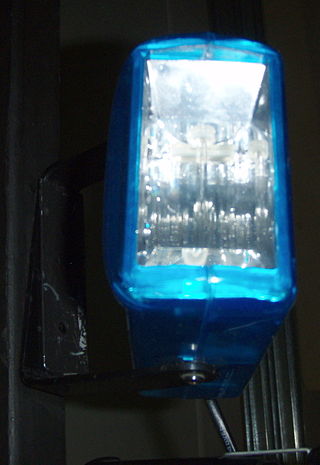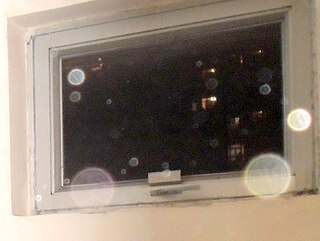A Flash of Light may refer to:
- A Flash of Light (film)
- A Flash of Light (Homeland)
- Shinkirari, the Japanese name of the manga series Talk to My Back
A Flash of Light may refer to:

The red-eye effect in photography is the common appearance of red pupils in color photographs of the eyes of humans and several other animals. It occurs when using a photographic flash that is very close to the camera lens in ambient low light.

The Lampyridae are a family of elateroid beetles with more than 2,000 described species, many of which are light-emitting. They are soft-bodied beetles commonly called fireflies, lightning bugs, or glowworms for their conspicuous production of light, mainly during twilight, to attract mates. Light production in the Lampyridae is thought to have originated as an honest warning signal that the larvae were distasteful; this was co-opted as a mating signal in the adults. In a further development, female fireflies of the genus Photuris mimic the flash pattern of Photinus species to trap their males as prey.
Flashback(s) or Flash Back may refer to:

A pelican crossing is a type of pedestrian crossing with traffic signals for both pedestrians and vehicular traffic, activated by call buttons for pedestrians, with the walk signal being directly across the road from the pedestrian. Pelican crossings are ubiquitous in many countries, but usage of the phrase "pelican crossing" is confined mainly to the UK and Ireland. The design was originally introduced in the United Kingdom; they are also found in the Isle of Man, the Channel Islands, Ireland, Indonesia and Australia. The crossings began to be phased out in Great Britain in 2016, being replaced with puffin crossings which have pedestrian signals above the call button rather than across the road.

Traffic lights, traffic signals, or stoplights – also known as robots in South Africa and Namibia – are signalling devices positioned at road intersections, pedestrian crossings, and other locations in order to control the flow of traffic.

A flash is a device used in photography that produces a brief burst of light at a color temperature of about 5,500 K to help illuminate a scene. A major purpose of a flash is to illuminate a dark scene. Other uses are capturing quickly moving objects or changing the quality of light. Flash refers either to the flash of light itself or to the electronic flash unit discharging the light. Most current flash units are electronic, having evolved from single-use flashbulbs and flammable powders. Modern cameras often activate flash units automatically.
Flashing may refer to:

Underwater photography is the process of taking photographs while under water. It is usually done while scuba diving, but can be done while diving on surface supply, snorkeling, swimming, from a submersible or remotely operated underwater vehicle, or from automated cameras lowered from the surface.

A strobe light or stroboscopic lamp, commonly called a strobe, is a device used to produce regular flashes of light. It is one of a number of devices that can be used as a stroboscope. The word originated from the Ancient Greek στρόβος (stróbos), meaning "act of whirling".

A light characteristic is all of the properties that make a particular navigational light identifiable. Graphical and textual descriptions of navigational light sequences and colours are displayed on nautical charts and in Light Lists with the chart symbol for a lighthouse, lightvessel, buoy or sea mark with a light on it. Different lights use different colours, frequencies and light patterns, so mariners can identify which light they are seeing.

A stun grenade, also known as a flash grenade, flashbang, thunderflash, or sound bomb, is a less-lethal explosive device used to temporarily disorient an enemy's senses. Upon detonation, a stun grenade produces a blinding flash of light and an extremely loud "bang". They are often used in close-quarters combat, door breaching, and riot control, typically to stun enemies or distract them.

A navigation light, also known as a running or position light, is a source of illumination on a watercraft, aircraft or spacecraft, meant to give information on the craft's position, heading, or status. Some navigation lights are colour-coded red and green to aid traffic control by identifying the craft's orientation. Their placement is mandated by international conventions or civil authorities such as the International Maritime Organization (IMO).
The Reverse-Flash is a name used by several supervillains appearing in American comic books published by DC Comics. Each iteration of the character serves as a foil and an enemy of the Flash.

The stroboscopic effect is a visual phenomenon caused by aliasing that occurs when continuous rotational or other cyclic motion is represented by a series of short or instantaneous samples at a sampling rate close to the period of the motion. It accounts for the "wagon-wheel effect", so-called because in video, spoked wheels sometimes appear to be turning backwards.

In photography, backscatter is an optical phenomenon resulting in typically circular artifacts on an image, due to the camera's flash being reflected from unfocused motes of dust, water droplets, or other particles in the air or water. It is especially common with modern compact and ultra-compact digital cameras.

In traffic engineering, there are regional and national variations in traffic light operation. This may be in the standard traffic light sequence or by the use of special signals.
Macromedia Flash may refer to:
Strobe, usually refers to a strobe light, in which light is emitted at regular intervals, usually as short flashes in rapid succession.
Flashing lights may refer to:
Untouchable or The Untouchable may refer to: